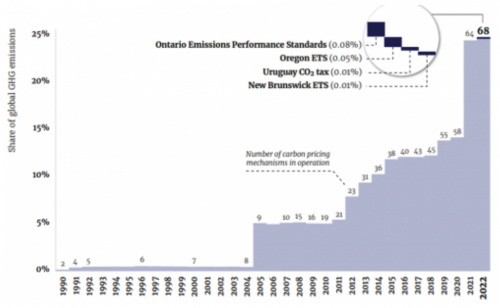Progress & Prospects for Carbon Pricing Around The World
This training provides a brief summary of the World Bank's latest annual report on carbon pricing, published in May 2023: State and Trends of Carbon Pricing 2023.
What is the state of play of carbon pricing?
Every year the World Bank publishes an annual volume on the global “State and Trends of Carbon Pricing.” Its 2023 report documents the good news that more jurisdictions than ever are pricing carbon and they are applying ever higher prices to a slightly greater share of total global emissions. The total revenues have reached a record high, about $95 billion.
The bad news is that global carbon prices “remain significantly below what is needed to achieve net zero by 2050 and meet the goals of the Paris Agreement.” For that to happen, the world's economy would need a carbon price of $50 to $100 per metric ton of carbon dioxide (CO2) by 2030. Given consumer and voter unrest over the current turmoil in world energy markets, that’s a politically challenging target to say the least.
How are the coverage and stringency of carbon pricing evolving?
Here are a few of the report’s high-level findings:
- As of this spring, 73 countries and subnational jurisdictions had carbon pricing initiatives (CPIs) – four more than a year ago, with three more underway. China is now the largest source of emissions covered by a carbon market. New CPIs this year included Uruguay and state or provincial initiatives in Oregon, New Brunswick, and Ontario. Of the world’s ten largest economies, only the United States and India have no national carbon pricing.
- Nearly a quarter—23 percent—of global greenhouse gas (GHG) emissions are now covered by CPIs, a very slight increase over 2021. The European Union’s huge Emissions Trading System (EU ETS), which covers power, industry, and aviation, will likely be expanded soon to encompass transportation and buildings.

- Carbon prices are going up, too. Prices on China’s carbon market, which covers more than 30 percent of its emissions, jumped 13 percent in the last six months of 2021 (albeit to a low level of only $8.50 per ton of carbon dioxide equivalent [tCO2e]). More dramatically, spot prices for emissions allowances in EU ETS, the world’s biggest carbon market, tripled over the course of 2021. A number of countries, including Canada, Ireland, and Switzerland, have price increases programmed into their national policies. Prices in Liechtenstein, Sweden, Switzerland, and Uruguay now exceed $120/tCO2e, though coverage ranges from only about 10% of emissions in Uruguay to 80% in Liechtenstein.

A good summary of measure the total impact of these three dimensions of carbon pricing effectiveness is global carbon pricing revenue, which reflects total emissions covered times the average carbon price. Last year those revenues reached a record $84 billion, about 60 percent higher than in 2020.

The promise and pitfalls of carbon pricing
“Such an impressive increase highlights carbon pricing’s burgeoning potential to reshape incentives and investment toward deep decarbonization,” the report notes. “Further, it illustrates carbon pricing’s potential role as a broader fiscal tool to contribute toward broader policy objectives, such as to restore depleted public finances, aid pandemic recovery, or support vulnerable sectors and communities to adapt to climate impacts and achieve just transitions.”
Still, the World Bank report cautions that only 4 percent of global emissions are now covered by carbon prices high enough to keep global heating to less than 2°C. To meet a much more stringent target of 1.5°C, the report cites estimates that a global carbon tax might need to reach as high as $250/tCO2e.The report acknowledges that carbon pricing policy is “politically challenging” and must be “fair, inclusive, and well communicated” to succeed. However, the report insists that carbon pricing has a “crucial role” to play in meeting global climate goals. In addition, the World Bank lauds the unique ability of carbon pricing to “improve energy and industrial efficiency, limit reliance on imported energy, promote cleaner air, protect and regenerate landscapes, and provide a valuable source of government revenue.”
- (0:00) Intro & Agenda
- (2:52) Why Carbon Pricing Is Needed As Much As Ever
- (11:25) Carbon Pricing is Expanding Worldwide
- (15:06) Time to Advocate for Carbon Dividends
- (23:20) For More Information
- Jonathan Marshall
- View or Download the Presentation Slides
- Download the video
Skip ahead to the following section(s):
- (0:00) Intro & Agenda
- (2:52) Why Carbon Pricing Is Needed As Much As Ever
- (11:25) Carbon Pricing is Expanding Worldwide
- (15:06) Time to Advocate for Carbon Dividends
- (23:20) For More Information
- Jonathan Marshall
- Instructions for printing this page on CCL Community.